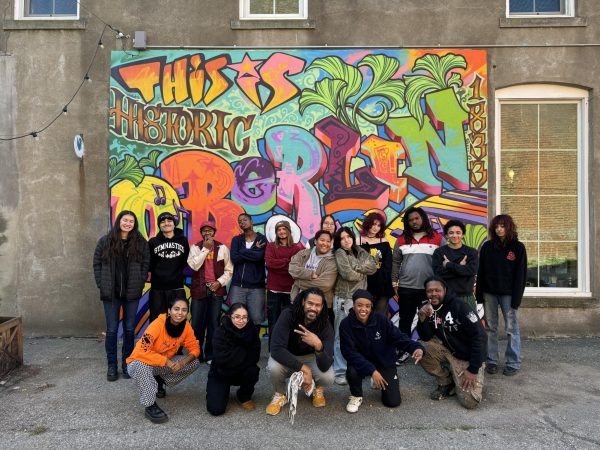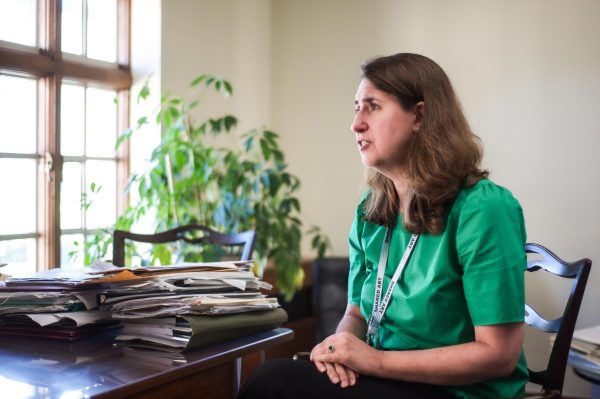Student Researchers Shed Light on AMAM Objects
The Allen Memorial Art Museum’s “A Spotlight on Student Research” event on Tuesday, part of its monthly Tuesday Teas, highlighted both the breadth and depth of research opportunities in the arts and humanities. Tuesday Tea events typically invite attendees to engage with specific pieces in the AMAM’s collection in the form of a talk given by a curator or faculty member.
Sometimes, though, Oberlin students lend their guidance and perspectives to the talks, as was the case this past Tuesday. Six student researchers gave brief presentations on works in the museum, including beadwork of Indigenous Cheyenne origin, a Keith Haring autograph card, and a pair of reclining nudes by Henri Matisse and Amedeo Modigliani.
“A Spotlight on Student Research” has historically been an annual event featuring a presentation from a single student researcher. This year, multiple students were first nominated to present by their professors or faculty advisors, then had to apply with a research abstract. College third-year Cecil Pulley’s presentation was titled “What’s in a Name?: Keith Haring’s Signature as Modern Relic.”
“[This presentation explores] why we think about artists the way that we do and whatʼs potentially problematic about some of the frameworks of art history,” Pulley said. “A lot of what Iʼm figuring out is why I think Haring has been made to be this martyr figure of contemporary art because he died of AIDS.”
Each presentation was around five minutes long and followed by a single audience question, culminating in a panel discussion with the six student researchers.
“The format of the talk was great, as it forced me to slim down an 80-page paper into its barest bones,” College fourth-year Ursula Hudak wrote in an email to the Review. “This actually helped a lot to focus my paper; a lot of my talk’s script is now in my paper’s introduction.”
Hudak’s presentation was titled “‘I dreamed I was liberated in my Maidenform bra’ — Reclining Nudes in the AMAM Bissett Collection.”
“[The presentation examines] a possible connection between the sculptural quality of these two reclining nudes by Matisse and Modigliani and their collectors, the Bissetts, being co-founders of the Maidenform company, whose products sculpted the female form,” Hudak wrote to the Review.
College fourth-year Elf Zimmerman’s presentation, “Cheyenne Beaded Pouches in the AMAM Collection,” built off of research they had completed in previous Winter Term projects focusing on the College’s ethnographic collection.
“When [the Oberlin College Museum] closed, all of the different collections went off to their respective departments,” Zimmerman said. “And then the ethnographic items mostly went to the Anthropology department, but a few of them were selected to go to the Allen. They just got split for arbitrary reasons — who gets to decide whatʼs art and what’s not; all sorts of fun questions there.”
Zimmerman’s research established the tribal origin and varying original functions of differently-sized beaded pouches that made their way to the AMAM collection after the dissolution of the Oberlin College Museum.
Some of the student researchers were already working at the AMAM prior to being selected to present. Fudi Fickenscher is a College fourth-year Art History major and student assistant to Ellen Johnson ʼ33 assistant curator of modern and contemporary art Sam Adams. Parker Niles is a College fourth-year Religion major and gallery guide at the AMAM.
“This position has afforded me a lot of opportunities to do art-historical research,” Fickenscher, who presented “Assemblage in Afro-Caribbean Arts and Identities,” said. “I had noticed at the Allen, thereʼs this work by Renée Stout, who is a DC-based artist and created this work about Haitian vodou and one of the spirits. I was really taken by that, and when I started writing the wall label for Sam [Adams], I realized I had a lot of theory behind it and a lot of knowledge about Haitian vodou. So I was able to sort of enter through that.”
Niles’ position also gave them closer access to AMAM staff. “I think because I was already working there, I definitely had a little bit more access than the average person,” Niles said. “But that being said, I think the Allen is very open for student collaborators and student researchers. And thatʼs what they want. They definitely want more students to be doing this.” Niles’ presentation,
“Material Matters: Sacred Himalayan Sculpture and its Implications in the AMAM Collection,” stressed the importance of “trying to understand that a lot of the objects in many museums’ collections are not just quote-un-quote ‘fine art’ but continue to be sacred objects, objects of worship, … so itʼs important to ask those questions about what is the proper care of these objects.”
The student perspectives shared on Tuesday, particularly those of Zimmerman and Niles, exhibit shared values between students and the AMAM. The AMAM has attempted to set itself on a revived trajectory in recent months, establishing a new five-year strategic plan complete with updated mission, vision, and values statements.
“The Allen already has a lot of initiatives itʼs working toward, which I really respect,” Hudak wrote. “The current movement towards writing museum labels that reflect the nuances in a pieceʼs history and interpretation is really important to me.”
Providing a platform for thoughtful, researched student input and critique of the institution is a critical aspect of progress for the AMAM. Hudak offered advice for students interested in exploring student research opportunities.
“Take classes in topics that really interest you, and if you write about something youʼd like to explore further, let your professor know!” Hudak said. “You can usually make it into a larger project. Finding a mentor in your chosen department is also very helpful, as they can help you plan a private reading and let you know about opportunities to share or publish your research.”
Research experience can help students look toward their careers or graduate degrees as well as reaping the benefits of knowledge creation. Students could even help to transform the institutions around them.







